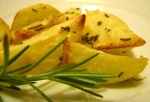 Rosemary (Rosmarinus officinallis L.) is a member of the Labiatae family and has been used for its medicinal properties since ancient times. In lipid systems, this spice is recognized as the greatest antioxidant agent (PEARSON et al., 1997) and, in addition, its major bioactive components have been shown to have antioxidant, antimicrobial, anti-inflammatory, antitumor and chemopreventive activities.
Rosemary (Rosmarinus officinallis L.) is a member of the Labiatae family and has been used for its medicinal properties since ancient times. In lipid systems, this spice is recognized as the greatest antioxidant agent (PEARSON et al., 1997) and, in addition, its major bioactive components have been shown to have antioxidant, antimicrobial, anti-inflammatory, antitumor and chemopreventive activities.
Its antioxidant properties have been attributed to a variety of quinone isoprenoids, phenolic diterpenes such as carnosic acid and carnosol, rosmarinic acid, as well as additional antioxidants including phenolic acids and flavonoids, capable of terminating free radical reactions and scavenging reactive oxygen species. and therefore prevent the oxidation of cholesterol and unsaturated fatty acids
Therefore, rosemary may be beneficial in atherosclerosis since the administration of antioxidants, combined with the reduction of plasma LDL levels, however it is still not clear how it acts, requiring further studies.
- Antioxidant: Rosemary extract helps to increase the retention of vitamin E. This vitamin is an antioxidant, delaying the development of oxidative changes, which age cells. The main sources of tocopherols are vegetable oils from corn, cotton, sunflower, soy, olive and peanut, with recommended consumption of 15 mg/day for men and women.
Furthermore, rosemary, as well as other herbs, can help with the acceptance of diets with reduced salt, adding more flavor, so the absence of salt is not so noticeable.
HOW TO USE?- It can be used to flavor vinegars, fish, meat, poultry and vegetables, it is often combined with potatoes, zucchini, eggplant and tomatoes prepared in olive oil.
- It does not lose its flavor during cooking, as other leaves do.
- In Italy, lamb is rarely prepared without this herb and roast poultry wrapped in rosemary sprigs is very popular. A similar effect can be obtained with rosemary branches placed over hot coals on barbecue grills.

